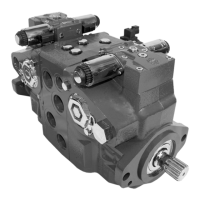What to do if my Danfoss H1T 045 reservoir oil level is low?
- Llaurie52Sep 10, 2025
If the oil level in your Danfoss Water Pump reservoir is low, fill the reservoir to the proper level.

What to do if my Danfoss H1T 045 reservoir oil level is low?
If the oil level in your Danfoss Water Pump reservoir is low, fill the reservoir to the proper level.
What to do if my Danfoss Water Pump operates in one direction only?
If your Danfoss Water Pump only operates in one direction, it could be due to control coil failure. Measure the resistance at the coil pins. The resistance should be 14.20 ? (24V) or 3.66 ? (12V) at 20°C [70°F]. Replace the coil if necessary.
How to resolve a high Danfoss Water Pump inlet vacuum issue?
If the inlet vacuum is too high in your Danfoss Water Pump, resulting in reduced system pressure, measure the charge inlet vacuum. Inspect the line for proper sizing. Replace the filter and confirm proper bypass operation.
What should I do if my Danfoss H1T 045 has cold oil?
If the oil in your Danfoss Water Pump is cold, it may be too viscous for proper function and the pump may cavitate. Allow the oil to warm up to its normal operating temperature with the engine at idle speed.
| Brand | Danfoss |
|---|---|
| Model | H1T 045 |
| Category | Water Pump |
| Language | English |
Records all changes and updates made to the service manual over time.
Provides a general overview of hydrostatic servicing for the pumps.
Outlines standard procedures and precautions for servicing.
Lists critical safety measures for hydraulic system maintenance.
Explains the meaning of common symbols used in Danfoss documents.
Describes the fundamental principles of a closed hydraulic circuit.
Explains the role of case drain lines and heat exchangers.
Details the internal mechanical design of tandem piston pumps.
Visual representation of H1T pump system components.
Electrical and hydraulic schematics for H1T tandem pump systems.
Detailed system schematic for tandem pumps with EDC.
Functionality and operation of pressure limiter valves.
Explains combined HPRV and charge check valve functions.
Details the CPRV function, settings, and flow characteristics.
How the Electrical Displacement Control system operates.
Describes the operational mechanisms and feedback of EDC.
Explains the manual override feature for pump control.
Details the MDC system, its operation, and limitations.
Discusses MDC deadband, restoring moment, and torque limits.
Functionality and electrical signal of the NSS.
Information regarding the M14 case gauge port.
Explains the function of CCO and brake release valves.
Defines minimum, rated, and maximum permissible input speeds.
Explains system pressure impact on unit life and application.
Discusses risks and responsibilities related to the braking system.
Defines application pressure and maximum working pressure limits.
Specifies maximum intermittent and minimum low loop pressures.
Explains servo pressure role in pump stroking and speed.
Details charge pressure control and its relation to case pressure.
Specifies minimum and maximum charge pump inlet pressures.
Discusses case pressure limits and potential damage.
Addresses pressure limits for the external shaft seal.
Outlines temperature and viscosity limits for operation.
General specifications for H1 pumps, including connections.
Guidance on optimal pump installation orientation and setup.
Detailed technical data and physical properties of H1 tandem pumps.
Specifies recommended intervals for fluid and filter maintenance.
Identifies ports and gauge installation for 045/053 models.
Identifies ports and gauge installation for 060/068 models.
A comprehensive guide for the initial startup of the pump.
Reiterates safety measures crucial during troubleshooting.
Guides for diagnosing and resolving electrical faults.
Steps for diagnosing issues related to the filter bypass system.
Procedures for diagnosing and fixing neutral position problems.
Steps to resolve issues where the pump operates in only one direction.
Diagnosing and addressing overheating in the system.
Steps to resolve when the system fails to operate in either direction.
Identifying and resolving causes of system noise and vibration.
Troubleshooting steps for slow or delayed system response.
General guidelines for preparing the pump for adjustments.
Procedure for calibrating the charge pressure relief valve.
Information regarding charge check/HPRV adjustment limitations.
Details on PL screens and adjustment for 060/068 models.
Steps for adjusting PL valves for clockwise and counterclockwise rotation.
How to adjust the displacement limiter on tandem pumps.
Procedure for setting the neutral position for EDC controls.
Instructions for performing mechanical neutral adjustment.
Guidelines for setting up the pump before adjustments.
Detailed servo adjustment procedures for tandem pumps.
General procedures for removing the pump for servicing.
Steps for repairing and installing the EDC control module.
Procedures for repairing or replacing pump control solenoids.
Instructions for repairing and assembling the MDC control.
How to repair or replace the angle sensor on the EDC.
Repair steps for EDC systems equipped with angle sensors.
Procedures for repairing or replacing shaft, seals, and bearings.
Steps for correctly installing shaft, seals, and bearings.
Specific repair procedures for the 045/053 charge pump.
Steps for installing the charge pump assembly.
Repair procedures for charge check/HPRV on 045/053 models.
Visual guide showing HPRV port connections.
Repair and replacement procedures for HPRV on 60/68 models.
Instructions for replacing the charge pressure relief valve.
Procedures for repairing control cut-off and brake valves.
General introduction to fasteners and plugs in the torque chart.
Comprehensive chart detailing fastener sizes and required torques.
Comprehensive chart detailing plug sizes and required torques.